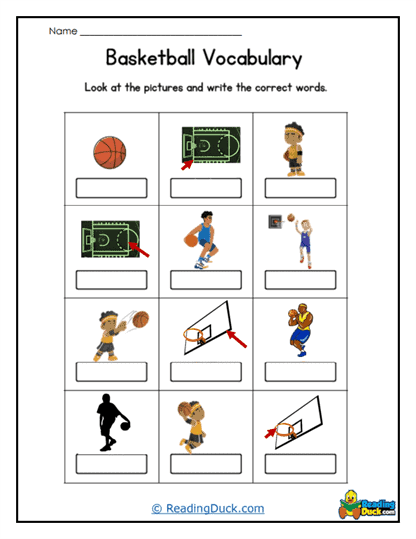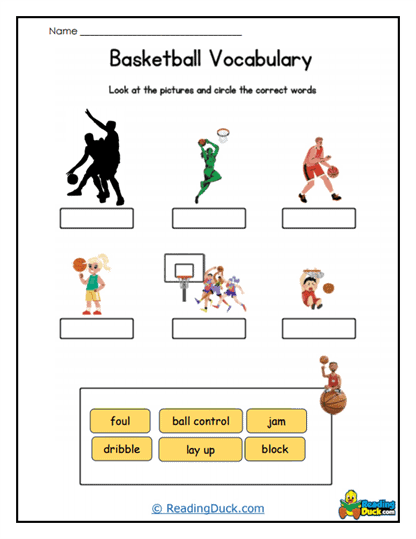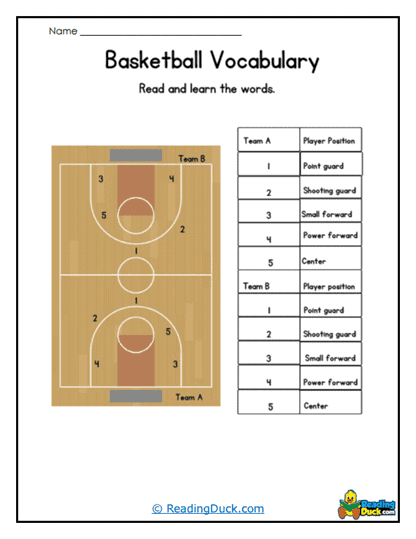Basketball Words Worksheets
About Our Basketball Vocabulary Word Worksheets
These worksheets can be used to familiarize students with the terminology and phrases commonly used in the sport of basketball. These worksheets provide an engaging way for learners to explore language through a lens that combines sports enthusiasm with academic growth. For teachers and homeschoolers, these worksheets serve as a bridge between physical education and language arts, offering a creative method to enrich students' understanding of the sport while simultaneously enhancing their vocabulary.
Through completing these sheets, students can develop a variety of language arts skills. For instance, learners might encounter matching activities, where they connect basketball terms like "dribble," "rebound," or "alley-oop" with their corresponding definitions. Additionally, exercises such as sentence construction help students practice using new vocabulary in context, boosting their grammar and writing skills. Word searches or crossword puzzles featuring basketball terms can reinforce spelling and recognition, while reading comprehension passages about the sport allow students to interpret and analyze text.
These worksheets do more than just teach words-they encourage critical thinking and contextual application. For example, a worksheet might include scenarios where students decide whether terms like "fast break" or "traveling" apply to a particular play. This not only deepens their grasp of basketball but also hones their analytical abilities. Contextual learning opportunities like these ensure that vocabulary is not learned in isolation but as part of a broader understanding of language and sportsmanship.
They develop a specialized vocabulary that enhances their communication skills, particularly in sports-related discussions or writing. This can be especially empowering for children who are fans of the game, allowing them to connect their interests with academic success. Moreover, these activities promote confidence as students learn to express themselves more clearly and accurately, whether they're describing a game or writing about their favorite player.
Another significant advantage of these worksheets is their ability to make learning fun and engaging. The sporty theme often resonates with students, keeping them motivated and attentive. Incorporating physical education topics into language arts lessons can break the monotony of traditional worksheet activities and provide a fresh, exciting context for learning. For homeschoolers, this approach can be particularly valuable in tailoring lessons to a child's unique interests, creating a more personalized and enjoyable educational experience.
They provide more than just knowledge of a sport—they open doors to enhanced literacy, critical thinking, and a love for learning. By blending the worlds of sports and education, teachers and homeschoolers can inspire students to see connections between their passions and academic growth. Whether used as a supplemental activity or a central part of a lesson plan, these worksheets are a valuable resource for fostering well-rounded development in young learners.
Basketball Vocabulary Words That We Explore
1. Dribble - Dribbling refers to bouncing the basketball on the floor repeatedly while moving or stationary. It is a fundamental skill used to maintain control of the ball and advance it toward the basket. Proper dribbling involves using the fingertips, not the palm, to better control direction and speed.
2. Rebound - A rebound occurs when a player retrieves the basketball after a missed shot attempt. Rebounds can be either offensive (retrieved by the shooting team) or defensive (retrieved by the opposing team). It is an essential skill for maintaining possession and often involves strong jumping and positioning techniques.
3. Alley-Oop - An alley-oop is a play where one player throws the ball near the hoop, and a teammate jumps, catches it mid-air, and scores, usually with a dunk or layup. This move requires precise timing, teamwork, and athleticism. It's often considered one of the most exciting plays in basketball.
4. Fast Break - A fast break is a quick offensive play where a team moves rapidly down the court after gaining possession. It often leads to scoring opportunities before the opposing defense has time to set up. Speed, coordination, and awareness are key to executing an effective fast break.
5. Traveling - Traveling is a violation that occurs when a player takes too many steps without dribbling the basketball. It disrupts the game flow and results in a turnover to the opposing team. Players must ensure they pivot correctly or dribble when moving to avoid this infraction.
6. Screen - A screen, also called a pick, is a legal move where an offensive player positions themselves to block a defender and create space for a teammate. The player setting the screen must remain stationary to avoid committing an offensive foul. It's a strategic tool used to create scoring opportunities.
7. Zone Defense - Zone defense is a defensive strategy where players guard specific areas of the court instead of marking individual opponents. It is designed to prevent easy scoring opportunities and force outside shots. This technique requires teamwork and strong communication to cover gaps effectively.
8. Point Guard - The point guard is a player responsible for leading the team's offense, often likened to the "quarterback" of basketball. They bring the ball up the court, organize plays, and distribute the ball to teammates. This position requires excellent vision, decision-making, and ball-handling skills.
9. Pivot - A pivot is a move where a player keeps one foot planted on the ground while moving the other foot to change direction. It is a crucial technique used to maintain possession of the ball while evading defenders. The pivot foot must remain stationary; otherwise, it results in a traveling violation.
10. Layup - A layup is a close-range shot where a player jumps toward the basket, laying the ball off the backboard and into the hoop. It's one of the simplest yet most effective scoring techniques. Proper footwork and angle are essential to executing a successful layup.
11. Shot Clock - The shot clock is a timer that limits the amount of time a team has to attempt a shot during possession, usually 24 or 30 seconds. It ensures that the game pace remains fast and prevents teams from stalling. If the team fails to shoot before the clock runs out, it results in a turnover.
12. Double-Dribble - Double-dribbling is a violation that occurs when a player dribbles the ball, stops, and then starts dribbling again, or when they use both hands simultaneously. This results in a turnover to the opposing team. Players must maintain continuous, single-handed dribbling to avoid this infraction.
13. Dunk - A dunk is a high-energy scoring move where a player jumps and slams the ball directly into the basket. It requires strength, agility, and precise timing. Dunks are crowd-pleasers and are often associated with dominant play.
14. Three-Point Line - The three-point line is an arc on the court that marks the distance from which a successful shot earns three points. Shots taken inside this arc are worth two points. The three-point shot is a valuable tool for teams looking to maximize scoring opportunities.
15. Assist - An assist occurs when a player passes the ball to a teammate who scores immediately after receiving it. Assists demonstrate teamwork and court vision. They are a key statistic for evaluating a player's ability to involve and support their team effectively.









